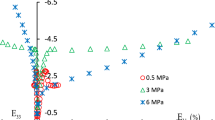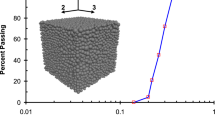Abstract
The paper presents a follow-up study of numerical modeling of complicated interplay of size effects in concrete structures. The major motivation is to identify and study interplay of several scaling lengths stemming from the material, boundary conditions and geometry. Methods of stochastic nonlinear fracture mechanics are used to model the well published results of direct tensile tests of dog-bone specimens with rotating boundary conditions. Firstly, the specimens are modeled using microplane material and also fracture-plastic material laws to show that a portion of the dependence of nominal strength on structural size can be explained deterministically. However, it is clear that more sources of size effect play a part, and we consider two of them. Namely, we model local material strength using an autocorrelated random field attempting to capture a statistical part of the combined size effect, scatter inclusive. In addition, the strength drop noticeable with small specimens which was obtained in the experiments could be explained either by the presence of a weak surface layer of constant thickness (caused e.g. by drying, surface damage, aggregate size limitation at the boundary, or other irregularities) or three dimensional effects incorporated by out-of-plane flexure of specimens. The latter effect is examined by comparison of 2D and 3D models with the same material laws. All three named sources (deterministic-energetic, statistical size effects and the weak layer effect) are believed to be the sources most contributing to the observed strength size effect; the model combining all of them is capable of reproducing the measured data. The computational approach represents a marriage of advanced computational nonlinear fracture mechanics with simulation techniques for random fields representing spatially varying material properties. Using a numerical example, we document how different sources of size effects detrimental to strength can interact and result in relatively complicated quasibrittle failure processes. The presented study documents the well known fact that the experimental determination of material parameters (needed for the rational and safe design of structures) is very complicated for quasibrittle materials such as concrete.
Similar content being viewed by others
References
Barenblatt GI (1996) Scaling, self-similarity, and intermediate asymptotics No. 14 in Cambridge texts in applied mathematics. Cambridge University Press, Cambridge
Bažant ZP, Oh BH (1983) Crack band theory for fracture of concrete. Mater Struct 16: 155–177
Bažant ZP, Oh BH (1986) Efficient numerical integration on the surface of a sphere. Zeitschrift für angewandte Mathematik und Mechanik (ZAMM) Berlin 66(1): 37–49
Bažant ZP, Pang SD (2007) Activation energy based extreme value statistics and size effect in brittle and quasibrittle fracture. J Mech Phys Solids 55(1): 91–131
Bažant ZP, Planas J (1998) Fracture and size effect in concrete and other quasibrittle materials. CRC Press, Boca Raton and London
Bažant ZP, Caner FC, Carol I, Adley MD, Akers SA (2000) Microplane model M4 for concrete: I. Formulation with work-conjugate deviatoric stress. J Eng Mech (ASCE) 126(9): 944–961
Bažant ZP, Pang SD, Vořechovský M, Novák D (2007a) Energetic-statistical size effect simulated by SFEM with stratified sampling and crack band model. Int J Numer Methods Eng 71(11): 1297–1320. doi:10.1002/nme.1986
Bažant ZP, Vořechovský M, Novák D (2007b) Asymptotic prediction of energetic-statistical size effect from deterministic finite element solutions. J Eng Mech (ASCE) 133(2):153–162. doi:10.1061/(ASCE)0733-9399(2007) 133:2(153)
Buckingham E (1914) On physically similar systems; illustrations of the use of dimensional equations. Phys Rev 4(4): 345–376. doi:10.1103/PhysRev.4.345
Caner FC, Bažant ZP (2000) Microplane model M4 for concrete: II. algorithm and calibration. J Eng Mech, ASCE 126(9): 954–961
Carmeliet J, de Borst R (1995) Stochastic approaches for damage evolution instandard and non-standard continua. Int J Solids Struct 32(8–9): 1149–1160. doi:10.1016/0020-7683(94)00182-V
Carmeliet J, Hens H (1994) Probabilistic nonlocal damage model for continua with random field properties. J Eng Mech, ASCE 120(10): 2013–2027
Červenka V, Pukl R (2005) Atena program documentation. Technical report, Červenka Consulting, Prague, Czech Republic. http://www.cervenka.cz
Červenka J, Bažant ZP, Wierer M (2005) Equivalent localization element for crack band approach to mesh-sensitivity in microplane model. Int J Numer Methods Eng 62(5): 700–726
de Borst R, Gutiérrez MA, Wells GN, Remmers JJC, Askes H (2004) Cohesive-zone models, higher-order continuum theories and reliability methods for computational failure analysis. Int J Numer Methods Eng 60(1): 289–315. doi:10.1002/nme.963
Dyskin A, van Vliet M, van Mier J (2001) Size effect in tensile strength caused by stress fluctuations. Int J Fract 108: 43–61
Fisher RA, Tippett LHC (1928) Limiting forms of the frequency distribution of the largest and smallest member of a sample. Proc Camb Philos Soc 24: 180–190
Gutiérrez MA, de Borst R (2002) Deterministic and probabilistic material length-scales and their role in size-effect phenomena. In: Corotis R, Schuëller G, Shinozuka M (eds) Structural safety and reliability: proceedings of the eighth International Conference on Structural Safety and Reliability ICoSSaR ’01, A.A. Balkema Publishers, Netherlands; Swets & Zeitinger, Newport Beach, California, USA, pp 129–136, abstract page 114
Hordijk D (1991) Local approach to fatigue of concrete. PhD thesis, Delft University of Technology, Delft, The Netherlands, ISBN 90/9004519-8
Jirásek M (1998) Nonlocal models for damage and fracture: comparison of approaches. Int J Solids Struct 35(31–32): 4133–4145
Lehký D, Novák D (2002) Nonlinear fracture mechanics modeling of size effect in concrete under uniaxial tension. In: Schießl P (ed) 4th International Ph.D. Symposium in Civil Engineering, volume 2, Millpress, Rotterdam, Munich, Germany, pp 410–417
Liu P, Der Kiureghian A (1986) Multivariate distribution models with prescribed marginals and covariances. Probab Eng Mech 1(2): 105–111
Mazars J, Pijaudier-Cabot G, Saouridis C (1991) Size effect and continuous damage in cementious materials. Int J Fract 51: 159–173
Novák D, Lawanwisut W, Bucher C (2000) Simulation of random fields based on orthogonal transformation of covariance matrix and latin hypercube sampling. In: Schuëller (ed) International Conference on Monte Carlo Simulation MC 2000, Swets & Zeitlinger, Lisse (2001), Monaco, Monte Carlo, pp 129–136
Novák D, Bažant ZP, Vořechovský M (2003a) Computational modeling of statistical size effect in quasibrittle structures. In: Der Kiureghian A, Madanat S, Pestana JM (eds) ICASP 9, International Conference on Applications of Statistics and Probability in Civil Engineering, held in San Francisco, USA, Millpress, Rotterdam, Netherlands, pp 621–628
Novák D, Vořechovský M, Rusina R (2003b) Small-sample probabilistic assessment—FREET software. In: Der Kiureghian A, Madanat S, Pestana JM (eds) ICASP 9, International Conference on Applications of Statistics and Probability in Civil Engineering, held in San Francisco, USA, Millpress, Rotterdam, Netherlands, pp 91–96
Novák D, Vořechovský M, Rusina R (2006) FReET—Feasible Reliability Engineering Efficient Tool. Technical report, Brno/Červenka Consulting, Czech Republic. http://www.freet.cz, program documentation—Part 2—User Manual
Pang SD, Bažant ZP, Le JL (2009) Statistics of strength of ceramics: Finite weakest-link model and necessity of zero threshold. Int J Fract. doi:10.1007/s10704-009-9317-8
Pietruszczak S, Mróz Z (1981) Finite element analysis of deformation of strain softening materials. Int J Numer Methods Eng 17: 327–334. doi:10.1002/nme.1620170303
Pijaudier-Cabot G, Bažant ZP (1987) Nonlocal damage theory. J Eng Mech, ASCE 113: 1512–1533
Remmers RJC, de Borst R, Needleman A (2003) A cohesive segments method for the simulation of crack growth. Comput Mech 31(1–2): 69–77. doi:10.1007/s00466-002-0394-z
van Mier J, van Vliet M (2003) Influence of microstructure of concrete on size/scale effects in tensile fracture. Eng Fract Mech 70: 2281–2306
van Vliet M (2000) Size effect in tensile fracture of concrete and rock. PhD thesis, Delft University of Technology, Delft, The Netherlands
van Vliet M, van Mier J (1998) Experimental investigation of size effect in concrete under uniaxial tension. In: Mihashi H, Rokugo K (eds) FRAMCOS-3. Aedificatio Publishers, Japan, pp 1923–1936
van Vliet M, van Mier J (1999) Effect of strain gradients on the size effect of concrete in uniaxial tension. Int J Fract 95: 195–219
van Vliet M, van Mier J (2000a) Experimental investigation of size effect in concrete and sandstone under uniaxial tension. Eng Fract Mech 65: 165–188
van Vliet M, van Mier J (2000b) Size effect of concrete and sandstone. Eng Fract Mech 45: 91–108
Vashy A (1892) Sur les lois de similitude en physique. Annales télégraphiques 19: 25–28
Vořechovský M (2004a) Statistical alternatives of combined size effect on nominal strength for structures failing at crack initiation. In: Stibor M (ed) Problémy lomové mechaniky IV (Problems of Fracture Mechanics IV), Brno University of Technology, Academy of Sciences—Institute of physics of materials of the ASCR, pp 99–106, invited lecture
Vořechovský M (2004b) Stochastic fracture mechanics and size effect. PhD thesis, Brno University of Technology, Brno, Czech Republic
Vořechovský M (2007) Interplay of size effects in concrete specimens under tension studied via computational stochastic fracture mechanics. Int J Solids Struct 44(9): 2715–2731. doi:10.1016/j.ijsolstr.2006.08.019
Vořechovský M (2008) Simulation of simply cross correlated random fields by series expansion methods. Struct safety 30(4): 337–363. doi:10.1016/j.strusafe.2007.05.002
Vořechovský M, Chudoba R (2006) Stochastic modeling of multi-filament yarns: II. Random properties over the length and size effect. Int J Solids Struct 43(3–4): 435–458. doi:10.1016/j.ijsolstr.2005.06.062
Vořechovský M, Novák D (2004) Modeling statistical size effect in concrete by the extreme value theory. In: Walraven J, Blaauwendaad J, Scarpas T, Snijder B (eds) 5th International Ph.D. Symposium in Civil Engineering, held in Delft, The Netherlands, A.A. Balkema Publishers, London, UK, vol 2, pp 867–875
Vořechovský M, Bažant ZP, Novák D (2005) Procedure of statistical size effect prediction for crack initiation problems. In: Carpinteri A (ed) ICF XI 11th International Conference on Fracture, held in Turin, Italy, Politecnico di Torino, pp CD–ROM proc, abstract page 1166
Vořechovský M, Chudoba R, Jeřábek J (2006) Adaptive probabilistic modeling of localization, failure and size effect of quasi-brittle materials. In: Soares et al (eds) III European Conference on Computational Mechanics (ECCM-2006), held in Lisbon, Portugal, National Laboratory of Civil Engineering, Springer, p 286 (abstract), full papers on CD-ROM
Weibull W (1939) The phenomenon of rupture in solids. Roy Swedish Inst Eng Res (Ingenioersvetenskaps Akad Handl) Stockholm 153: 1–55
Author information
Authors and Affiliations
Corresponding author
Rights and permissions
About this article
Cite this article
Vořechovský, M., Sadílek, V. Computational modeling of size effects in concrete specimens under uniaxial tension. Int J Fract 154, 27–49 (2008). https://doi.org/10.1007/s10704-009-9316-9
Received:
Accepted:
Published:
Issue Date:
DOI: https://doi.org/10.1007/s10704-009-9316-9




